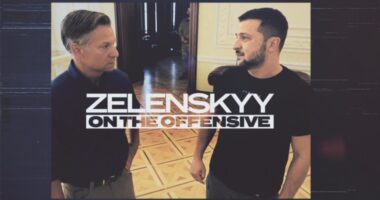
Allen Kay, an advertising executive whose work sold Xerox copiers to Super Bowl viewers (Brother Dominic the monk) and saved lives after the 2001 terrorist attacks (“If you see something, say something”), died on Nov. 27 at his home in Weehawken, N.J. He was 77.
The cause was cardio-respiratory failure, said his wife, Susan (Brody) Kay.
Mr. Kay won some 30 Clio Awards and was inducted into two advertising Halls of Fame for the innovative and often whimsical campaigns he and his collaborators crafted when he worked at Needham, Harper & Steers from 1971 until 1982 when he left as senior vice president and creative director and later at his own agencies, Korey Kay & Partners and the Advertising Company.
“We have five basic guidelines for developing advertising,” he said in an interview for Guy Kawasaki’s book “How to Drive Your Competition Crazy: Creating Disruption for Fun and Profit” (1995). “Start with the customer. Live with the client. Uncover the obvious. Keep it simple. And follow through.”
His television commercials reached millions of viewers. But he made his greatest impact with the slogan he conjured for New York’s Metropolitan Transportation Authority after the Sept. 11, 2001, terrorist attack on the World Trade Center in Lower Manhattan helped make people all over the world more security conscious.
“People understood that officials could not be everywhere, so the M.T.A. was asking them to participate in each other’s safety,” Mr. Kay told The New York Times in 2007.
The understated six-word battle cry for civic engagement that he created resulted from research in Israel, where being on the lookout for terrorism is routine, and with rider focus groups.
“The way we saw the assignment was a kind of a loose-lips-sink-ships, circa 2003,” Mr. Kay told The Times in 2003. “The irony was that in World War II, the message was to keep your mouth shut. And now the message is, in the trains, don’t.”
A number of appeals were rejected as too long or complicated, among them “If you see a package without a person, don’t keep it to yourself” — which was, at the very least, ambiguous.
“Be suspicious of things that look suspicious” was discarded, too. Transit officials later explained that they had decided that wording was all but guaranteed to generate crank calls, since New Yorkers tend to regard one another and their possessions warily to begin with.
“There are a lot of suspicious-looking people,” Katherine N. Lapp, the transit agency’s executive director, said in 2003.
Posters bearing the slogan “If you see something, say something” were installed in the subway system in 2003, one week before the American invasion of Iraq began.
“I’m proud of what it’s done and the potential it has to do more,” Mr. Kay told The Times in 2010. “Some things you just can’t stop. But if it is stoppable, and that thought makes someone think twice and say something that stops something, that’s its reason for being.”
In a statement after Mr. Kay’s death, John J. McCarthy, the M.T.A.’s chief of external relations, said: “By essentially serving as a counterweight to ‘Snitches get stitches,’ the iconic ‘See something, say something’ campaign has over the years unquestionably saved lives.”
In 1976, when Mr. Kay was at Needham, he was credited with kicking off the use of the Super Bowl as a global showcase for premiering innovative (and exorbitant) advertisements. For Super Bowl X, he and the copywriter Steven Penchina created a spot for the Xerox high-speed duplicator.
It featured a monk named Brother Dominic (played by Jack Eagle, a borscht-belt comedian and former big-band trumpeter), who was shown toiling away in the basement of an abbey, writing a manuscript by hand. When the father superior asks him for 500 copies, he luckily finds a friend with a Xerox copying machine and gets the job done speedily.
“It’s a miracle,” his fellow monks exclaim.
Advertising Age proclaimed the Brother Dominic campaign one of the top 50 of the 20th century.
By positioning Honda as “the car that sells itself” for dealers in New York, New Jersey and Connecticut, Mr. Kay and his colleagues created a folk hero out of a mythical salesman they named Danny. Customers would walk into the showroom and announce, “I’ll take it,” before Danny could even make his pitch.
In 1984, Mr. Kay persuaded an upstart company called Eagle Telephonics to spend $10,000 to hire an engineer affiliated with the American Museum of Natural History to build a radio-controlled robotic eagle that alighted on the head of a deskbound executive in a commercial.
“Notice anything unusual about my office?” the executive asks. The ad ends with a tagline: “Now all other phones are endangered species.”
A campaign for the law firm Jacoby & Meyers took the “Winning isn’t everything; it’s the only thing” approach to the goal of legal action.
“Remember that guy?” one commercial began. “Who came in second in the last New York Marathon? Neither do we. Winning is everything.”
Another commercial opens with the song “Hail to the Chief” and shows portraits of the historical figures Horatio Seymour, Charles C. Pinckney, Hugh L. White and Lewis Cass. “Presidential elections are like lawsuits,” a voice-over says. “You’re nobody unless you win.” (The ad does not elaborate that they lost to Ulysses S. Grant, Thomas Jefferson, Martin Van Buren and Zachary Taylor, respectively.)
Mr. Kay was already working for the M.T.A. when he coined the famous security alert. In 1993, he wrote a poster message to riders that began by parodying the vexing problem of inaudible loudspeaker announcements with a gap-laden message: “You m ght n t bel eve this, but we real y are w rking on th p blic addr ss sy t m.”
Mr. Kay and his partners were nothing if not aggressive in pursuing accounts. In 1982, they learned that WCBS-TV in New York was shopping for a new agency, but by that time the station’s director of communications, Joseph Passarella, had narrowed the search to three other agencies and barred new bidders.
Mr. Kay and Ms. Korey responded like true New Yorkers: They resorted to threats. They sent Mr. Passarella an audition reel with a note that read: “We have your dog. Look at this reel if you want to see him again.” After calling his wife to make sure that she hadn’t acquired a dog since he left home that morning, Mr. Passarella looked at the reel, liked it and hired Korey Kay for the $3 million account.
Allen Steven Kay was born on Nov. 25, 1945, in the Bronx. His father, Samuel, worked at Grey Advertising as a comptroller. His mother, Estelle (Citron) Kay, operated a Comptometer, a key-driven mechanical calculator, for a large firm.
After moving with his family to New Jersey from the Washington Heights neighborhood of Manhattan, Allen graduated from Fair Lawn High School and went on to earn a degree in advertising from ArtCenter College of Design in Los Angeles in 1967.
He worked for McCann Erickson and Jack Tinker & Partners before joining Needham in 1971. He founded Korey Kay & Partners with Lois Korey in 1982 and the Advertising Company in 2016.
In addition to his wife, he is survived by his daughters, Jill and Deana Kay; his sister, Robin Cortese; and six grandchildren.
Mr. Kay had been working on an autobiography but died before finishing it. It was tentatively titled “Death Runs in My Family.”
Source: | This article originally belongs to Nytimes.com









